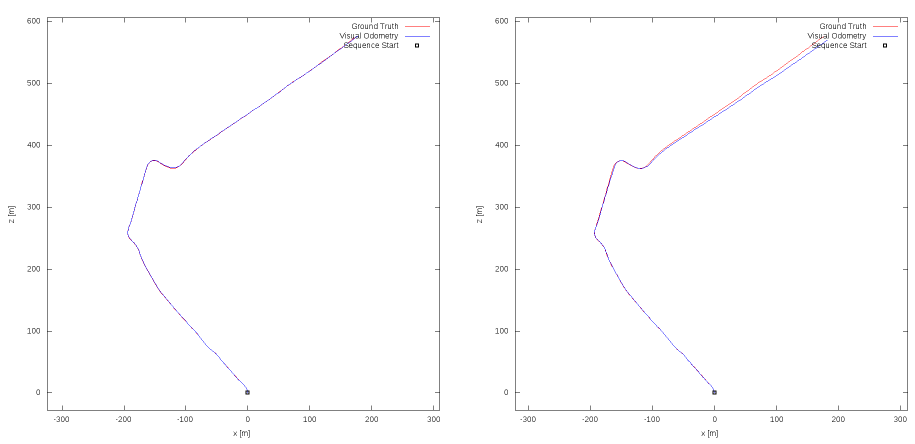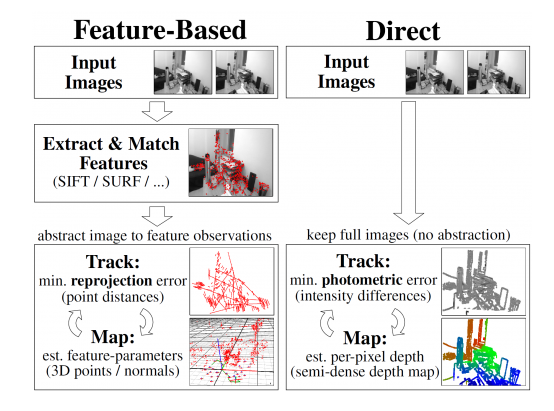SLAM學習筆記——(一)SLAM分類
SLAM( Simultaneous Localization and Mapping)是指同步定位與地圖構建。定位和建圖兩個問題相互依賴,準確的定位依賴於正確的地圖,而構建正確的地圖又需要準確的定位,這是一個迭代的過程。
目前的SLAM根據硬體裝置的不同主要有兩種:
1.基於鐳射雷達的SLAM
基於鐳射雷達構建場景是古老並且可信的方法,鐳射雷達也是精確場景使用最多的SLAM感測器。它們提供機器人本體與周圍環境障礙物間的距離資訊。常見的鐳射雷達,例如SICK、Velodyne還有我們國產的rplidar等,都可以拿來做SLAM,但總體來說鐳射雷達的價格都是非常昂貴。鐳射雷達能以很高精度測出機器人周圍障礙點的角度和距離,從而很方便地實現SLAM、避障等功能。
2.基於視覺的SLAM
基於視覺的SLAM主要是通過攝像頭採集來的資料進行同步定位與地圖構建。相比於鐳射雷達,攝像頭的價格就是要低的多,但有些工業攝像頭的價格還是很高的。此外視覺感測器採集的影象資訊要比鐳射雷達得到的資訊豐富,所以更加利於後期的處理
這裡我們通過下圖來比較比較兩種方法的區別(資料來源於KITTI):
注意:左圖為Lidar Odometry and Mapping (鐳射雷達)
右圖為ORB-SLAM2 (視覺)
我們可以觀察到對於同一個場景的測試,ORB-SLAM2在後半程出現了明顯的誤差,這是因為累積漂移(accumulated drift)所引起的,所以對於視覺SLAM要進行迴環檢測(Loop closure detection)。
由於個人主要是研究Visual SLAM,所以我們接下來對於這個方向進行細分。
(一)
按照視覺感測器主要分為三種:
單目攝像頭(Monocular Camera)
雙目攝像頭(Binocular Camera)
深度攝像頭(RGB-D Camera)
深度攝像頭可以通過time of flight等方法來直接獲得影象及對應的深度資訊,優點在於方便獲得深度資料,缺點在於成本高,體積大,室外環境基本報廢。
雙目攝像頭可以通過三角方法計算出深度資訊,市面上有一些深度攝像頭也是直接基於雙攝像頭來做的。然而雙目攝像頭在目標距離較遠的時候會退化成單目。因此近年來大量的研究都是圍繞單目進行的。
單目SLAM可以通過臨近影象匹配計算出攝像頭位姿的變換,在兩個視角上進行三角測距又可以得出對應點的深度資訊。通過這樣迭代的過程可以實現定位及建圖。
(二)
A、根據對影象處理的方式非為:
- 直接法(Direct)
- 非直接法(Indirect)(一般為基於特徵(Feature-Based))
區別如下圖:
B、根據構建地圖的稀疏程度分為:
- 稀疏(Sparse)
- 稠密(Dense)
但注意:一般這兩種方法會同時使用,具體的組合及方法(包含相關論文)如下:
(1)Sparse + Indirect:
monoSLAM:
A. Davison, I. Reid, N. Molton, and O. Stasse. MonoSLAM:
Real-time single camera SLAM. Transactions on Pattern
Analysis and Machine Intelligence (TPAMI), 29, 2007. 2
PTAM:
G. Klein and D. Murray. Parallel tracking and mapping for
small AR workspaces. In International Symposium on Mixed
and Augmented Reality (ISMAR), 2007. 2
ORB-SLAM
R. Mur-Artal, J. Montiel, and J. Tardos. ORB-SLAM: a versatile
and accurate monocular SLAM system. Transactions
on Robotics, 31(5):1147–1163, 2015. 2, 11
(2)Dense + Indirect
L. Valgaerts, A. Bruhn, M. Mainberger, and J. Weickert.
Dense versus sparse approaches for estimating the fundamental
matrix. International Journal of Computer Vision
(IJCV), 96(2):212–234, 2012. 2
R. Ranftl, V. Vineet, Q. Chen, and V. Koltun. Dense monocular
depth estimation in complex dynamic scenes. In International
Conference on Computer Vision and Pattern Recognition
(CVPR), 2016. 2
(3)Dense + Direct:
DTAM
R. Newcombe, S. Lovegrove, and A. Davison. DTAM:
Dense tracking and mapping in real-time. In International
Conference on Computer Vision (ICCV), 2011. 2, 3
J. St¨uhmer, S. Gumhold, and D. Cremers. Real-time dense
geometry from a handheld camera. In Pattern Recognition
(DAGM), 2010. 2, 3
LSD-SLAM
J. Engel, T. Sch¨ops, and D. Cremers. LSD-SLAM: Largescale
direct monocular SLAM. In European Conference on
Computer Vision (ECCV), 2014. 2, 11
(4)Sparse + Direct
DSO
J. Engel, V. Usenko and D. Cremers,
A Photometrically Calibrated Benchmark For Monocular Visual Odometry,
arXiv:1607.02555, July 2016.
J. Engel, V. Koltun and D. Cremers,
Direct Sparse Odometry,
arXiv:1607.02565, July 2016.


